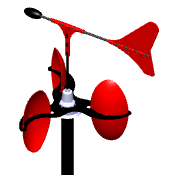Selecting the Right Anemometer: A Comprehensive Purchasing Guide
Selecting the Right Anemometer: A Comprehensive Purchasing Guide
Blog Article
Anemometers Revealed: Recognizing Their Value in Ecological Surveillance and Precaution
The duty of anemometers in ecological monitoring and safety measures is often taken too lightly, yet their relevance is undeniable. From weather forecasting to air travel safety, anemometers play a critical function in providing precise data that educates decision-making processes and improves total safety.
Background of Anemometers
The development of anemometers can be mapped back to the old human beings where rudimentary wind gauging tools were initial utilized. One of the earliest well-known anemometers was the hemispherical mug anemometer designed by Leon Battista Alberti in the 15th century.
In the 18th century, the prominent scientist John Thomas Romney Robinson introduced the Robinson anemometer, which included 4 hemispherical cups placed on straight arms that expanded from a main axis. This design ended up being a requirement in meteorological dimensions as a result of its precision and reliability. Over the years, advancements in modern technology brought about the development of more modern anemometers, including ultrasonic anemometers and laser Doppler anemometers, using raised accuracy and performance in gauging wind rate and instructions. The background of anemometers showcases an impressive trip of innovation and progression in the field of meteorology.
Types of Anemometers
Throughout the area of meteorology, different types of anemometers have been established to precisely gauge wind speed and instructions. Sonic anemometers make use of ultrasonic signals to determine wind speed and direction properly. Hot-wire anemometers operate based on the principle that the cooling impact of wind on a heated cord is proportional to the wind speed.
Applications in Meteorology
Having actually reviewed the various sorts of anemometers utilized in meteorology for gauging wind rate and instructions, it is important to explore their functional applications in the area. Anemometers play an important function in weather forecasting by giving real-time and exact data on wind problems (anemometer). Meteorologists use anemometers to check wind speed and instructions to anticipate climate patterns, concern cautions for extreme climate events like twisters, cyclones, and storms, and assess weather for air travel security
In weather forecasting, anemometers help in understanding regional and local wind patterns, which are essential for predicting climate modifications and figuring out climatic trends. These tools are also utilized in study to study microclimates, urban warmth islands, and air contamination dispersion. Additionally, anemometers are utilized in agriculture to optimize plant management practices, such as watering and chemical application, based upon wind conditions.
Relevance in Air Travel Safety
An important element of ensuring aeronautics security depends on the precise surveillance of wind conditions making use of anemometers. Anemometers play a vital role in aeronautics by giving real-time information on wind speed and instructions, aiding pilots in making notified choices throughout liftoff, trip, and landing. Solid and unforeseeable winds can dramatically affect aircraft procedures, making it important for aeronautics authorities click here now to rely on precise wind dimensions to ensure the safety of travelers and staff.

In the vibrant setting of aviation, where even minor changes in wind rate and instructions can have profound impacts, anemometers stand as essential tools for promoting safe and secure air traveling.
Function in Environmental Study
Anemometers play a crucial function in ecological study by giving essential data on wind speed and instructions. By accurately measuring wind characteristics, anemometers help researchers analyze this article the activity of toxins in the air, analyze the influence of commercial exhausts, and anticipate the spread of contaminants in the environment.


Conclusion
In conclusion, anemometers have actually played a vital duty in ecological tracking and safety and security measures. Recognizing the importance of anemometers is vital for precisely measuring wind rate and direction, which is crucial for predicting climate patterns, making sure risk-free aeronautics operations, and performing environmental researches.
One of the earliest recognized anemometers was the hemispherical mug anemometer developed by Leon Battista Alberti in the 15th century. Over see it here the years, developments in modern technology led to the development of even more modern anemometers, consisting of ultrasonic anemometers and laser Doppler anemometers, supplying boosted accuracy and efficiency in determining wind rate and direction. Hot-wire anemometers run based on the principle that the cooling impact of wind on a warmed wire is proportional to the wind rate. Meteorologists use anemometers to keep an eye on wind speed and direction to anticipate climate patterns, issue warnings for extreme weather events like hurricanes, storms, and twisters, and analyze atmospheric conditions for aviation safety and security.
Understanding the importance of anemometers is crucial for precisely measuring wind speed and instructions, which is essential for forecasting climate patterns, ensuring safe air travel procedures, and carrying out environmental research studies. (anemometer)
Report this page